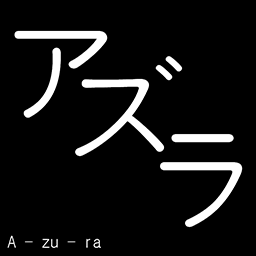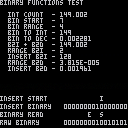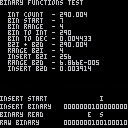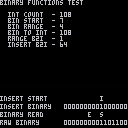============================================================
Pico-8 Binary Functions Set
PRGM ver. 1.1.1
Created by A-zu-ra MANUAL ver. 1.1.2
============================================================
This function set includes functions that will:
- Convert a given integer into a 16-item table of
binary values
- Read a portion of the generated 16-item table
- Insert a given table into another table at any position
- Converts a given table of binary values into an integer
Through these functions, you can essentially use one integer
to serve multiple purposes. This document will not only
cover how the functions work, but also how to apply them in
the context of Pico-8's persistent data.
Included with this function set is a brief test program
showcasing all of the functions in action.
INT COUNT increments once a frame in both whole number
and decimal and is a base for all of the functions in
the test.
BIN START is the START variable of binread.
BIN RANGE is the RANGE variable of binread.
BIN TO INT tests reconversion of binary back to integer.
BIN TO DEC tests reconversion of binary back to decimal.
B2I + B2D is the values of BIN TO INT and BIN TO DEC
as a single value.
RANGE B2I is the integer value of binread.
INSERT B2I is the integer value of binread inserted into
another table via binins.
RANGE B2D and INSERT B2D work the same as RANGE B2I and
INSERT B2I, but for the decimal subset.
The bottom of the function test contains the RAW BINARY of
the integer, as well as the range of binread and starting
point of binins visualized. In the test code is a section
that has EDIT THESE BELOW VALUES! and EDIT THESE ABOVE
VALUES!, so feel free to experiment with the values to get
a better feel of how things go together.
------------------------------------------------------------
inttobin(value, decimal)
value An integer within Pico-8's acceptable range
(-32768 to 32767)
decimal A boolean that decides whether or not to pull
from either whole number or decimal (0 or 1)
RETURNS a table with 16 values of either 0 or 1
This function takes an acceptable value that you give it
and creates a 16-value table, each containing either a
0 or a 1 in it. The following examples are formatted to
be human readable; the order is reversed when the table
is created (i.e. the first example below is, from the
table's perspective, 0000100000000000).
16 0000000000010000
136 0000000010001000
9570 0010010101100010
-32768 1000000000000000
-3530 1111001000110110
------------------------------------------------------------
binread(table, start, range)
table A table generated via inttobin
start The starting point to read from
(remember, tables are 1-indexed)
range How many values from the starting point
to read from
RETURNS a table with a number of values
specified in range
This function takes a table that is generated from
inttobin and extracts a user specified portion of it.
This function requires two more additional values: the
starting point (so you can choose from a different
section of the table), and a range (so you can extract
larger values).
Since the table has the binary values in reverse order,
the function will appear to go from right to left when
imagining the ranges in a human readable order. The
following examples will hopefully give a better visual
of this.
Assume that table is {1, 1, 0, 0, 1, 1, 0, 0,
1, 1, 0, 0, 1, 1, 0, 0}.
(table, 1, 1) S
0011001100110011 bintoint: 1
(table, 1, 5) E S
0011001100110011 bintoint: 19
(table, 4, 7) E S
0011001100110011 bintoint: 102
(table, 9, 4) E S
0011001100110011 bintoint: 3
------------------------------------------------------------
binins(table, table2, start)
table The table you want to append values to
table2 A table generated via inttobin or binread
start What point in the target table to start at
RETURNS the target table with table2 appended to it,
starting from the bit position specified by the user
This function allows you to combine one table into
another at any place. It's advised that you calculate
the size of the table that you want to insert if you
plan on using this function multiple times on one table.
Much like the binread function, the function will appear
to go from right to left when imagining the start point
in a human readable order.
Assume that the target table is empty.
table2 = {1, 0, 0, 1} -- 1001
(table, table2, 1) S
0000000000001001 bintoint: 9
table2 = {1, 0, 1, 0, 1, 1} -- 110101
(table, table2, 4) S
0000000110101000 bintoint: 424
table2 = {0, 1, 1, 0, 1} -- 10110
(table, table2, 7) S
0000010110000000 bintoint: 1408
Remember to calculate your table sizes.
table2 = {1, 0, 1, 1} -- 1101 YES
table3 = {0, 1, 1} -- 110
(table, table2, 3) 3 2
(table, table3, 8) S S
0000001100110100 bintoint: 820
(Both tables added in with no
problems)
Otherwise, calling the function again will overwrite
those bits if the sizes conflict with the positioning.
table2 = {1, 0, 1, 1} -- 1101 NO
table3 = {0, 1, 1} -- 110
(table, table2, 6) 3 2
(table, table3, 8) S S
0000001100100000 bintoint: 800
(Table 3 overwrites last two bits
of table 2)
------------------------------------------------------------
bintoint(table, decimal)
table A table generated via inttobin, binread, or
binins
decimal A boolean that decides whether or not to write
to either whole number or decimal (0 or 1)
RETURNS an integer representation of the binary table
This function will take a binary table that you give it
and convert it back into an integer.
0000000000001000 8
0000000001000010 66
0000101000101000 2600
1000100100001000 -30456
------------------------------------------------------------
How to apply code in context with Pico-8 persistent data
-- Two 8-bit values (43 tokens)
c = {}
v = {6,6}
for i=1,#v do
binins(c,binread(inttobin(v[i],0),1,8),((i-1)*8)+1)
end
f = bintoint(c,0)
(Throw f into persistent data via dset)
To adjust this for other equal bit values, replace B and
adjust the amount of items used in the v table:
for i=1,#v do
binins(a,binread(inttobin(v[i]),1,B),((i-1)*B)+1)
end
#v B Max Leftover bits
16-bit 1 16 65535* None left over
15-bit 1 15 32767 1 bit
14-bit 1 14 16383 2 bits
13-bit 1 13 8191 3 bits
12-bit 1 12 4095 4 bits
11-bit 1 11 2047 5 bits
10-bit 1 10 1023 6 bits
9-bit 1 9 511 7 bits
8-bit 2 8 255 None left over
7-bit 2 7 127 2 bits
6-bit 2 6 63 4 bits
5-bit 3 5 31 1 bit
4-bit 4 4 15 None left over
3-bit 5 3 7 1 bit
2-bit 8 2 3 None left over
1-bit 16 1 1 None left over
*Any number past 32767 will be represented as a negative
value counting towards 0.
-- Different size bit values (47 tokens)
d = {}
s = {5,8}
v = {31,255}
c = 1
for i=1,#v do
binins(d,binread(inttobin(v[i],0),1,8),c)
c += s[i]
end
f = bintoint(d)
(Throw f into persistent data via dset)
To adjust this for other values and bit sizes, ensure that:
- s and v have the same amount of items
- the sum of all numbers in s is less than or equal to 16
- the values in v are within the boundaries of the
respective bit count specified in s
============================================================
Version History
PROGRAM TKN BYTE
v1.1.1 161 418
Optimized inttobin function.
v1.1.0 171 435
inttobin and bintoint can now read from and write
to decimal.
v1.0.0 136 377
Initial release.
*Token and byte values based on the functions alone;
they do not factor in the included function test.
MANUAL
v1.1.2
Modified examples for applying code in context with
Pico-8 persistent data to work with PRGM v1.1.1.
v1.1.1
Changed version number system.
v1.1.0
Added explanation of additional test functions,
as well as new decimal option for inttobin and
bintoint.
v1.0.2
Removed mention of empty table generation in the
function summary.
v1.0.1
Added bintoint readouts on binread and binins.
v1.0.0
Initial manual.











 9 comments
9 comments